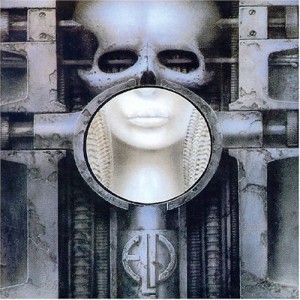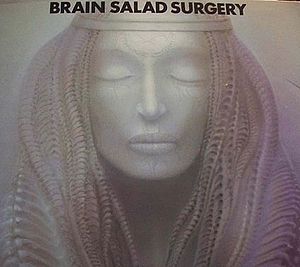 I have a difficult relationship with Emerson Lake & Palmer’s most recognizable album Brain Salad Surgery. It’s not the incredible, yet somehow quease-inducing cover. It’s not the devotion that the record spurs on. It is that, of the seventies prog records that came out, even in a field packed with King Crimson, Yes, and a host of hard-rockers that flirted with the prog line like Uriah Heep, etc., there is none more prog than Brain Salad Surgery.
I have a difficult relationship with Emerson Lake & Palmer’s most recognizable album Brain Salad Surgery. It’s not the incredible, yet somehow quease-inducing cover. It’s not the devotion that the record spurs on. It is that, of the seventies prog records that came out, even in a field packed with King Crimson, Yes, and a host of hard-rockers that flirted with the prog line like Uriah Heep, etc., there is none more prog than Brain Salad Surgery.
 Debuting in November 1973, the record should not have surprised anyone. Tarkus set the stage for Brain Salad Surgery although it was only their second release, and BSS was as far from the fusion-jazz-classical-rock of their debut and third record Trilogy as you likely could get. The group was working that line between the rock repurposing of classical compositions (Pictures At An Exhibition) and this new spirit of menace and a harder edge. BSS had a pop radio ballad (“Still, You Turn Me On”) with a wah-wah noodle in the choruses and a bar-room tale in the skiffle “Benny The Bouncer,” but the first two tracks surely would have warned listeners of more of the same as before to come — covering the Church of England hymn “Jerusalem (And Did Those Feet In Ancient Times…)” and covering part of Alberto Ginastera’s 1st Piano Concerto as “Toccata.” Then side one closes with the first part of “Karn Evil 9” and things take a turn for the different.
Debuting in November 1973, the record should not have surprised anyone. Tarkus set the stage for Brain Salad Surgery although it was only their second release, and BSS was as far from the fusion-jazz-classical-rock of their debut and third record Trilogy as you likely could get. The group was working that line between the rock repurposing of classical compositions (Pictures At An Exhibition) and this new spirit of menace and a harder edge. BSS had a pop radio ballad (“Still, You Turn Me On”) with a wah-wah noodle in the choruses and a bar-room tale in the skiffle “Benny The Bouncer,” but the first two tracks surely would have warned listeners of more of the same as before to come — covering the Church of England hymn “Jerusalem (And Did Those Feet In Ancient Times…)” and covering part of Alberto Ginastera’s 1st Piano Concerto as “Toccata.” Then side one closes with the first part of “Karn Evil 9” and things take a turn for the different.
How different? Well, as the name alludes to, the most memorable musical theme of the composition (broken up here into three movements) is that of a twisted, psychedelic carnival (hence “karn evil”). Taken as a whole, “Karn Evil 9” lasts thirty minutes and was the latest in the ongoing volley between prog bands over who would produce the longest “epic.” Genesis had debuted the side-long “Supper’s Ready” a year before on Foxtrot. A couple years later Yes would offer four side-long songs (ranging from 18 to 21 minutes each) as Tales From Topographic Oceans. The ominous screech of a supercomputer at the end of “Karn Evil 9, 3rd Impression” with it shouting to humanity, “I’m perfect! Are you?” presages Rush’s 2112 and it’s climactic shrieks of doom to the human race. In other words, you could say this album, if not kicking off the prog rock escalation of excess, certainly fueled it heavily.
The title of the record is supposedly a euphemism for oral sex, albeit a highly arcane euphemism. It was nicked from the Dr. John song, “Right Place, Wrong Time,” though I’m of a mind not to believe that Mac Rebennack was using his term to describe fellatio (maybe chemicals ingested during the gris-gris?) It replaced the original title, “Whip Some Skull On Yer,” which I suppose does sound more like someone “giving you head.” All this becomes equally clear and shrouded in mystery thanks to the cover artwork by H.R. Giger. Known later for his designs in the original Alien movie, and later for the disturbing work on Debbie Harry’s solo album Koo-Koo, Giger’s world has always consisted of biomechanical and extraterrestrial creatures that kind of resembled things vaginal and phallic. To have the image of skull-emblazoned gates of death, with a label cutout for where the skull’s jaw would be, then having the corresponding inner sleeve art showing a woman’s ashen yet pouty lips beckoning with a full-on pucker, would not have been beyond Giger’s capacity. It is one of his tamest creations.
 The lyrics were once again assisted by Pete Sinfield, although the truth is he probably wrote them based on loosely offered suggestions. Sinfield was the primary lyricist during bassist/guitarist Greg Lake’s time in King Crimson V1 and had been a co-conspirator from ELP’s very beginnings. But it could not have been a dream assignment for a writer known more for Lovecraftian lyricism to have his bits prefaced by a) lyrics by William Blake (“Jerusalem”), b) a thorny instrumental (“Toccata”), and c) a drinking tune (“Benny The Bouncer”). I imagine it was just the times, right?
The lyrics were once again assisted by Pete Sinfield, although the truth is he probably wrote them based on loosely offered suggestions. Sinfield was the primary lyricist during bassist/guitarist Greg Lake’s time in King Crimson V1 and had been a co-conspirator from ELP’s very beginnings. But it could not have been a dream assignment for a writer known more for Lovecraftian lyricism to have his bits prefaced by a) lyrics by William Blake (“Jerusalem”), b) a thorny instrumental (“Toccata”), and c) a drinking tune (“Benny The Bouncer”). I imagine it was just the times, right?
The legend of ELP, such as it is, begins here. Carl Palmer fused his jazz chops and a hard-hitting rock style on this record, and would further burnish his reputation on the live version of “Karn Evil 9” on the Welcome Back My Friends, To The Show That Never Ends record, wherein he would break down the song and then build it back up, sounding like a train pulling away from the station in the process. Greg Lake would forever have to deal with that lyric, “Welcome back, my friends…” for the rest of his career. It is as synonymous to him as “Satisfaction” or “Start Me Up” is to Mick Jagger. Keith Emerson cemented his fame as an ass-kicker behind the keys.
But unlike some other records from 1973 which have become timeless and continue to enthrall new audiences, Brain Salad Surgery cannot be extricated from the year in which it debuted. The Hammond organ and those knob-tweaked synths, the gall of co-opting a hymn and an avant-garde composition for a pop record (ostensibly), and for filling the rest with the audacity of a three-section concerto all speak to its age and sound even more foreign and bizarre in the context of ADD-addled 2013. Can we even suffer a song longer than five minutes now, much less thirty?
A couple years ago I wrote Popdose’s mini-series 50Prog50 and offended a lot of purists for excluding ELP and, specifically, for excluding this record. I had my reasons. Although I respect it and listen to it at least once a year, it is never without major reservations. I am painfully aware of the largesse above flat ambition, the itchiness I get when I court the impression the band was much too far into their “we don’t make music, we make art” aesthetic, and the requirement that when I put on this disc, I have to be in a specific mood. This is not good time, cruising music. It’s not beer-weeping breakup music. It’s not even “take me seriously” music. It is something that swims, and sometimes is adrift, in it’s own private ocean. You get in the water with it only when you feel you have the capacity to swim with it, and at no other time.
So maybe it is art in that aspect. Art is not always Picasso’s cubist Three Musicians. Sometimes it is Picasso’s Guernica. It is meant to provoke and disturb, and even in some ways to pervert. It can’t all be wallpaper with a repeating fleur de lys. And in that sense I can appreciate the achievement of Brain Salad Surgery, so much that I have owned it on multiple formats. It is something I always come back to, but cannot groove with. It rattles my head but doesn’t really stir the soul. You say that it is good, but never, “Man, that’s goooood…” if you get where I’m coming from.
ELP would have successes afterward, specifically with revamps of Aaron Copeland’s legendary “Fanfare For The Common Man” and Henry Mancini’s “Theme From Peter Gunn” which, if I’m not mistaken, appeared on the most unfortunate Love Beach record. They would splinter apart, reform (sometimes in different configurations like the Cozy Powell ELP or 3 with vocalist Robert Berry), and reform again as the core unit of old. Keith Emerson would hang back in the late ’90s and 2000’s because of carpal tunnel syndrome, which is to be expected from his hyper-athletic form of keyboard performance. Greg Lake had surgery that dropped his voice down a step. Carl Palmer would go back and forth between ELP and Asia because, clearly, Asia had a bigger audience. ELP has not, in recent years, been able to mount the kind of third-act that other groups from the early ’70s have. While that is a disappointment to me on one level, it is completely understandable to me on several others. More than any other group, their music is representative of the tolerances of each album’s times, and 2013 is like a whole other universe in comparison to 1973. Even the most generous modern music critic has to listen to the latest batch of hits and admit the supercomputer has taken over. Where does “Toccata” fit in on the dubstep continuum?






Comments